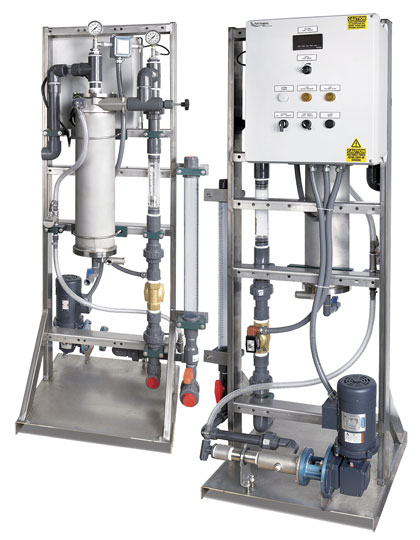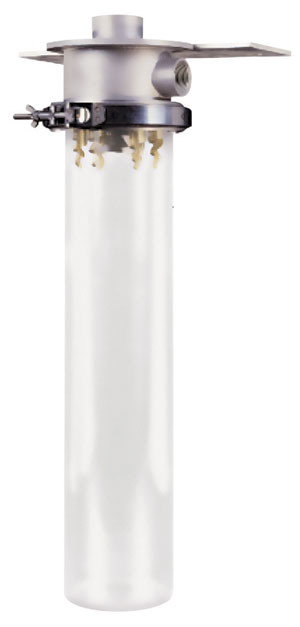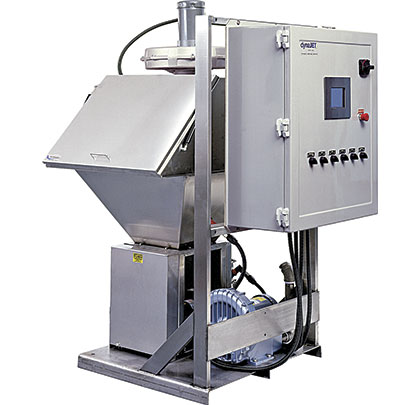Historians have determined that one of the first recorded examples of water treatment occurred more than 4,000 years ago when the ancient Egyptians used almonds to coat the inside of storage vessels as a way to help clarify river water. Two millennia later, or around 77 A.D., the Romans became the first to use alum (a colloquial name for “hydrated potassium aluminum sulfate”) as a coagulant during water treatment. By the mid-1700s, alum was regularly being used as a coagulant in municipal water-treatment activities in England.
The point is that almost from the dawn of civilized societies people knew that untreated water that was to be consumed or used for cooking, bathing or cleaning could be dangerous. Those concerns remain relevant today as nearly every city, town, village, hamlet, and burgh in the world, whether large or small, rural or urban, has some sort of operation in place to remove impurities from water that will be used for consumption or wastewater that has been fouled and will be either reconstituted or introduced to the environment.

Featured Image: The dynaJET™ Dry Polymer Preparation System was developed by Fluid Dynamics™ to be ideal for water-treatment applications because it utilizes a negative-pressure, blower-induced conveyance system to transport and disperse dry polymer prior to the wetting process, which ensures effective and complete polymer-particle wetting.
Above: The dynaBLEND™ Liquid Polymer Blending System from Fluid Dynamics™ is a high-energy, non-mechanical liquid-polymer activation and blending technology that effectively activates all types of liquid polymers, in the process rendering mechanical blenders obsolete except in low-flow applications.
The challenge through the years has been to identify, design, produce and implement treatment systems and operations that safely and reliably result in water and wastewater that will cause no harm to those that consume it or use it for other activities. This article will illustrate how wet or dry polymer preparation systems, which aid in the critical coagulation and flocculation stages of municipal water treatment, can help water-treatment facilities efficiently deliver the clean water that is demanded and required by the public and the environment.
THE CHALLENGE
One of the main challenges in municipal water treatment is finding a way to reduce the water’s level of turbidity to acceptably low levels. Turbidity is a measurement that determines the amount of cloudiness or haziness that can be found in untreated water. Turbidity is caused by the presence of microscopic particles—usually bacteria, dirt, pathogens, metal ions, phosphates, plant materials, or minuscule pieces of crushed rock or stone—that are generally invisible to the naked eye.
Countries around the world set standards for turbidity levels in drinking water. In the United States, for example, systems that use conventional or direct-filtration methods for water treatment cannot produce water with turbidity levels at the plant outlet that are higher than 1.0 nephelometric turbidity units (NTU). Additionally, all samples for turbidity must be less than or equal to 0.3 NTU for at least 95 percent of the samples that are taken in any given month. Globally, the World Health Organization has determined that the turbidity level of drinking water should not be more than 5 NTU at any time and should ideally be below 1 NTU in order to ensure the health of the user.
The inherent problem in attempting to decrease the turbidity of municipal drinking or wastewater is that the microscopic particles that are present are so light in weight that they either will settle very slowly over time (as measured in hours, days or weeks), or will not settle at all. This means the water treater must rely on different methods to remove the particles in a timely and efficient manner.
One of the more popular of these methods is known as coagulation and flocculation. Coagulation and flocculation are chemical processes wherein the particles in water are coaxed into forming larger clusters, known as flocs, which makes them easier to remove through a settling or filtration process. Specifically, coagulation neutralizes the electrical charges of the suspended particles, allowing them to clump together in a mass that will settle or be trapped in a filter. Flocculation is a gentle agitation of the water that encourages the floating particles to gather into masses that can be filtered or will settle.
This clumping process is driven by the chemical reagents, or coagulants/flocculants, that possess the capability to allow the suspended particles to attach to each other and form larger clusters that can be more easily removed from the water. Two of the more common types of chemical reagents that are used in municipal water-treatment systems are:
- Ferric chloride. Another name for iron (III) chloride, ferric chloride breaks down when dissolved in water, which gives it the ability to sufficiently form suspended solid particles into flocs
- Alum. Alum is an astringent compound that allows the negatively charged suspended particles to clump together so they will be able to be more easily removed from settling basins or trapped during filtration
A potential roadblock to successful removal of the clumped particles is that the flocs that are formed through the use of the alum and ferric chloride can be very fragile. This means that any agitation of the water that is required by the settling or filtration processes has the potential to break the flocs apart. When this happens, the floc-removal processes can be compromised, which leads to water that does not meet the standards for purity and turbidity levels. This also means that the water will need to be re-treated, which is both costly and time-consuming.
To combat floc failure, polymers are injected into the water during the coagulation stage. These polymers possess the ability to strengthen the flocs, which allows them to withstand the rougher treatment they will encounter during the filtration or settling processes. The ultimate challenge in these circumstances is to find and employ a polymer-preparation technology that can adequately introduce the polymers to the municipal water-treatment process.
THE SOLUTION
When selecting a polymer to use in water treatment, the treatment-plant operator has two choices: wet or dry. In both cases, polymer-preparation systems are necessary that cannot only deliver the injection rates that are required, but can also handle the growing number of polymers that are now available, some of which are exceptionally delicate and must be handled with extreme care.
Recognizing the needs and demands in this critical area of municipal water treatment, Fluid Dynamics™, a leading manufacturer of liquid and dry polymer preparation systems, and a division of the Neptune™ Chemical Pump Company, which is a product brand of PSG®, a Dover company, offers the patented dynaBLEND™ Liquid Polymer Blending System and dynaJET™ Dry Polymer Preparation System.
The dynaBLEND is a high-energy, non-mechanical liquid-polymer activation, and blending technology that has been designed to effectively activate all types of liquid polymers. The key to its operation is its HydroAction Technology, which produces more than six times the mixing energy per unit volume than comparable technologies.

The heart of the dynaBLEND system is its patented HydroAction Technology, which produces in excess of six times the polymer mixing energy per unit volume than comparable mechanical polymer mixers.
The HydroAction Technology’s three unique stages of operation are what separate it from its competitors:
- Stage 1: Pressure drop across a specially designed variable-orifice water-control valve produces a high-velocity water jet, which travels at approximately 70 feet per second. The water jet is aimed directly at, and impinges on, the polymer as it enters the mixing chamber. At this point, the polymer coils up and is not susceptible to damage.
- Stage 2: In the concentric mixing chambers, the newly blended polymer recirculates multiple times for additional exposure to non-damaging turbulence, completing the blending process. The recirculation ensures that the polymer solution is present directly after the point of injection for an ideal activation and blending environment.
- Stage 3: The mixing energy then naturally diminishes in the dynaBLEND’s concentric chambers, while the optimized flow path through the chambers ensures optimum polymer performance by preventing the polymer from disrupting the three-stage activation and blending process.
The three-stage method of operation ensures that the dynaBLEND delivers high mixing energy without the use of mechanical impellers, which can cause polymer damage and gelling. Polymers that do not gel or get damaged maximize the treatment plant’s polymer investment by reducing actual polymer use.
Additionally, the dynaBLEND’s innovative non-mechanical mixing chamber delivers a high degree of reliability over competitive mechanical technologies. Also, the system’s injection check valve has been designed with easy disassembly and inspection in mind, eliminating a maintenance concern that troubles other polymer make-down systems.
The dynaJET technology is ideal for water-treatment applications because it utilizes a negative-pressure, blower-induced conveyance system to transport and disperse the dry polymer prior to the wetting process. Dispersing dry polymer prior to it coming into contact with the water or wastewater ensures effective polymer-particle wetting. The result is reduced mixing and hydration times, higher polymer performance, lower chemical costs, and fewer moving parts, which results in increased reliability and reduced maintenance concerns.
Other benefits of Fluid the dynaJET system include:
- Separation of polymer prior to wetting, which prevents polymer buildup at the volumetric feeder and plugging/clogging of the conveyance system
- Multiple hopper configurations that can be designed to meet every water-treatment operation’s unique needs
- Hoppers that have been designed for loading without the need for stairs or platforms, resulting in increased safety for the operator, along with cleaner operation and a reduced chance of polymer spills
- Six standard control panels, providing the flexibility to choose the features that best meet the requirements of any operation without accruing any additional customization costs
CONCLUSION
Human, plant, and animal life would cease to exist without potable water, while untreated wastewater poses a threat to all living beings and the environment. Even civilizations as old as the Egyptians circa 2,000 B.C. knew this and took measures to ensure that they had a safe drinking-water supply. Today, protecting the water supply is a front-of-mind concern for all societies and humans will continue to flourish only if it is done sufficiently.

By using a blower-induced pneumatic conveyance system to transfer the polymer from the feeder to the wetting head, the dynaJET system is able to reduce mixing and hydration times, deliver higher polymer performance and lower chemical costs.
That makes the work done at water-treatment plants pivotal in the success or failure of the planet, and a number of highly successful ways to treat water and wastewater have been created over the years. These critical systems are only truly successful, however, if they can consistently, efficiently, and effectively—from time, cost, and reliability perspectives—perform as intended. Helping ensure the reliable performance of water-treatment operations are the highly efficient and reliable preparation systems that introduce the polymers that protect the coagulation and flocculation processes that are so crucial in a properly operating municipal water-treatment system. ◆
Greg Kriebel is the National Sales Manager for Fluid Dynamics™, a division of Neptune™ Chemical Pump Company. He can be reached directly at greg.kriebel@psgdover.com or 215.699.8700, ext. 3361. Fluid Dynamics is a premier developer of polymer equipment and make-down systems for use in a variety of industries. Neptune is a product brand of PSG®, a Dover company. PSG is comprised of several leading pump companies, including Abaque®, Almatec®, Blackmer®, Ebsray®, EnviroGear®, Griswold™, Mouvex®, Neptune™, Quattroflow™, RedScrew™, and Wilden®. You can find more information on Fluid Dynamics at fluiddynamics1.com, on Neptune at neptune1.com, and on PSG at psgdover.com.
____________________________________________
MODERN PUMPING TODAY, March 2017
Did you enjoy this article?
Subscribe to the FREE Digital Edition of Modern Pumping Today Magazine!
![]()


